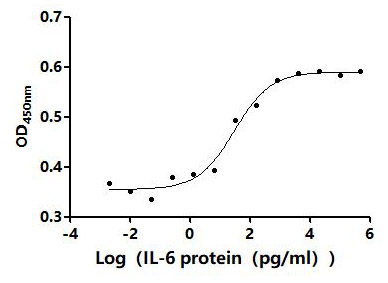Recombinant Arabidopsis thaliana LRR receptor-like serine/threonine-protein kinase FLS2 (FLS2), partial
-
中文名稱:擬南芥FLS2重組蛋白
-
貨號(hào):CSB-YP880781DOA
-
規(guī)格:
-
來源:Yeast
-
其他:
-
中文名稱:擬南芥FLS2重組蛋白
-
貨號(hào):CSB-EP880781DOA-B
-
規(guī)格:
-
來源:E.coli
-
共軛:Avi-tag Biotinylated
E. coli biotin ligase (BirA) is highly specific in covalently attaching biotin to the 15 amino acid AviTag peptide. This recombinant protein was biotinylated in vivo by AviTag-BirA technology, which method is BriA catalyzes amide linkage between the biotin and the specific lysine of the AviTag.
-
其他:
-
中文名稱:擬南芥FLS2重組蛋白
-
貨號(hào):CSB-BP880781DOA
-
規(guī)格:
-
來源:Baculovirus
-
其他:
-
中文名稱:擬南芥FLS2重組蛋白
-
貨號(hào):CSB-MP880781DOA
-
規(guī)格:
-
來源:Mammalian cell
-
其他:
產(chǎn)品詳情
-
純度:>85% (SDS-PAGE)
-
基因名:FLS2
-
Uniprot No.:
-
別名:FLS2; At5g46330; MPL12.13; MPL12.8LRR receptor-like serine/threonine-protein kinase FLS2; EC 2.7.11.1; Protein FLAGELLIN-SENSING 2; Protein FLAGELLIN-SENSITIVE 2
-
種屬:Arabidopsis thaliana (Mouse-ear cress)
-
蛋白長度:Partial
-
蛋白標(biāo)簽:Tag?type?will?be?determined?during?the?manufacturing?process.
The tag type will be determined during production process. If you have specified tag type, please tell us and we will develop the specified tag preferentially. -
產(chǎn)品提供形式:Lyophilized powder
Note: We will preferentially ship the format that we have in stock, however, if you have any special requirement for the format, please remark your requirement when placing the order, we will prepare according to your demand. -
復(fù)溶:We recommend that this vial be briefly centrifuged prior to opening to bring the contents to the bottom. Please reconstitute protein in deionized sterile water to a concentration of 0.1-1.0 mg/mL.We recommend to add 5-50% of glycerol (final concentration) and aliquot for long-term storage at -20℃/-80℃. Our default final concentration of glycerol is 50%. Customers could use it as reference.
-
儲(chǔ)存條件:Store at -20°C/-80°C upon receipt, aliquoting is necessary for mutiple use. Avoid repeated freeze-thaw cycles.
-
保質(zhì)期:The shelf life is related to many factors, storage state, buffer ingredients, storage temperature and the stability of the protein itself.
Generally, the shelf life of liquid form is 6 months at -20°C/-80°C. The shelf life of lyophilized form is 12 months at -20°C/-80°C. -
貨期:Delivery time may differ from different purchasing way or location, please kindly consult your local distributors for specific delivery time.Note: All of our proteins are default shipped with normal blue ice packs, if you request to ship with dry ice, please communicate with us in advance and extra fees will be charged.
-
注意事項(xiàng):Repeated freezing and thawing is not recommended. Store working aliquots at 4°C for up to one week.
-
Datasheet :Please contact us to get it.
相關(guān)產(chǎn)品
靶點(diǎn)詳情
-
功能:Constitutes the pattern-recognition receptor (PPR) that determines the specific perception of flagellin (flg22), a potent elicitor of the defense response to pathogen-associated molecular patterns (PAMPs). Flagellin-binding to the receptor is the first step to initiate the innate immune MAP kinase signaling cascade (MEKK1, MKK4/MKK5 and MPK3/MPK6), resulting in enhanced resistance against pathogens. Binding to the effector AvrPto1 or to the phosphatase hopD2 from Pseudomonas syringae blocks the downstream plant immune response.
-
基因功能參考文獻(xiàn):
- LLG1 constitutively associates with the PAMP receptor FLAGELLIN SENSING 2 (FLS2) and the elongation factor-Tu receptor, and forms a complex with BRASSINOSTEROID INSENSITIVE 1-ASSOCIATED RECEPTOR KINASE 1 in a ligand-dependent manner, indicating that LLG1 functions as a key component of PAMP-recognition immune complexes PMID: 28507137
- Combination of two identified mutations into a single allele further increased FLS2-mediated responses to the Erwinia amylovora flagellin peptide in Arabidopsis. PMID: 27270917
- The study demonstrates that the G proteins are directly coupled to the FLS2 receptor complex and regulate immune signaling through both pre-activation and post-activation mechanisms. PMID: 27043937
- MKKK7 negatively regulates FLS2 signaling and basal immunity. PMID: 26769563
- We found that all tested variants of AVR3a suppress defense responses triggered by flg22 and reduce internalization of activated FLS2. Moreover, we discovered that AVR3a associates with the Dynamin-Related Protein 2 (DRP2) PMID: 26348328
- each investigated root tissue is able to perceive flg22 if FLS2 is present and that tissue identity is a major element of microbe-associated molecular patterns (MAMPs)perception in roots. PMID: 25627577
- A tissue- and cell type-specific map of FLS2 expression has been created correlating with prominent entry sites and target tissues of plant bacterial pathogens. PMID: 25205577
- Functionally redundant RXLR effectors from Phytophthora infestans act at different steps to suppress early flg22-triggered immunity. PMID: 24763622
- FLS2 complexes regulate the expression of AtCLCd, further supporting a role for AtCLCd in pathogen-associated molecular pattern (PAMP)-triggered immunity (PTI). PMID: 24449384
- Degradation of FLS2 plays a role in desensitizing Arabidopsis cells to bacterial flagellin or flg22 peptide. PMID: 24220680
- Our findings identify that VPS37-1, and likewise VPS28-2, regulate late FLS2 endosomal sorting and reveals that ESCRT-I is critical for flg22-activated stomatal defenses involved in plant immunity PMID: 24385929
- FLS2-BIK1 dissociation and FLS2-BAK1 association are not sufficient for FLS2-mediated defense activation, but the proposed FLS2 phosphorylation site Ser-938 and FLS2 kinase activity are needed for overall defense activation and for appropriate flg22-stimulated phosphorylation of BIK1 and homologs PMID: 23637603
- The structural mechanism of the FLS2-flg22 interaction and subsequent receptor-mediated signalling. [Review] PMID: 23053766
- these data reveals the molecular mechanisms underlying FLS2-BAK1 complex recognition of flg22 and provide insight into the immune receptor complex activation. PMID: 24114786
- FLS2 localizes to bona fide endosomes via two distinct endocytic trafficking routes depending on its activation status. PMID: 23085733
- FLS2 does not recognize CLV3 and that the shoot apical meristem is immune to bacteria independently of CLV3 perception. PMID: 22923673
- The results indicate that ligand perception in FLS2 is a complex molecular process that involves LRRs from both the outermost and innermost LRRs of the FLS2 ectodomain. PMID: 22634763
- FLS2 triggered activation of pathogenesis-related genes in Arabidopsis. PMID: 22080602
- FLS2 is a PRR, which recognizes a part of bacterial flagellin. FLS2 forms a PTI signalling complex, some components of which are guarded by R proteins. PMID: 21726371
- FLS2 functions beyond flagellin perception to detect other microbe-associated molecular patterns PMID: 21576467
- Flagellin Sensitive2 (FLS2) accumulation was reduced in etr1 and ein2, indicating a requirement of ethylene signaling for FLS2 expression. PMID: 20592040
- These results suggest a particularly important role of FLS2-mediated resistance to coronatine-deficient mutant Pst DC3000 bacteria. PMID: 20457804
- FLS2 tolerated mild underglycosylation occurring in stt3a but was sensitive to severe underglycosylation induced by tunicamycin treatment PMID: 20007973
- these results show that FLS2 constitutes the pattern-recognition receptor that determines the specificity of flagellin perception. PMID: 16377758
- Species-specific differences in flagellin perception abilities to identify LeFLS2 as the flagellin receptor in Ararbidopsis. PMID: 17530419
- Data suggest that the reduced mobility of FLS2 after binding flg22 and its existence in monomeric form are important mechanistic features of FLS2 early signaling. PMID: 17925310
- we propose that both domains of Pseudomonas syringae pv tomato DC3000 AvrPtoB act together to support the virulence of PtoDC3000 in Arabidopsis through their ability to eliminate FLS2 from the cell periphery. PMID: 19062288
顯示更多
收起更多
-
亞細(xì)胞定位:Cell membrane; Single-pass type I membrane protein. Endosome membrane; Single-pass type I membrane protein.
-
蛋白家族:Protein kinase superfamily, Ser/Thr protein kinase family
-
組織特異性:Ubiquitously expressed.
-
數(shù)據(jù)庫鏈接:
Most popular with customers
-
Recombinant Human Heat-stable enterotoxin receptor (GUCY2C), partial (Active)
Express system: Mammalian cell
Species: Homo sapiens (Human)
-
Recombinant Human Neuropilin-1 (NRP1) (Active)
Express system: Mammalian cell
Species: Homo sapiens (Human)
-
Recombinant Human IGF-like family receptor 1 (IGFLR1), partial (Active)
Express system: Mammalian cell
Species: Homo sapiens (Human)
-
Recombinant Human Glucagon-like peptide 1 receptor (GLP1R), partial (Active)
Express system: Mammalian cell
Species: Homo sapiens (Human)
-
Recombinant Human Tumor-associated calcium signal transducer 2 (TACSTD2), partial (Active)
Express system: Mammalian cell
Species: Homo sapiens (Human)
-
Recombinant Human C-type lectin domain family 4 member C (CLEC4C), partial (Active)
Express system: Mammalian cell
Species: Homo sapiens (Human)
-


















